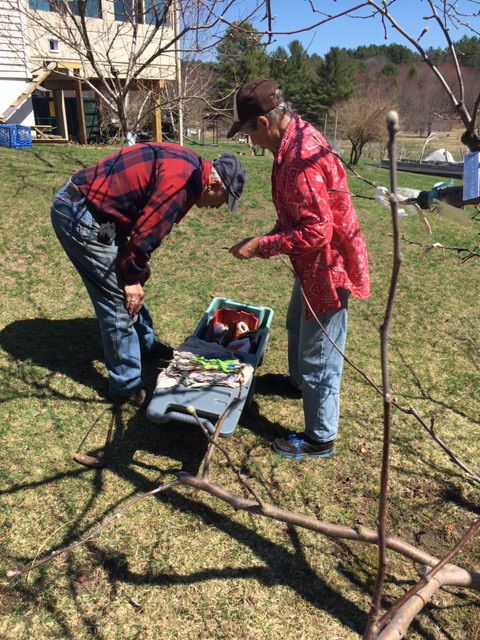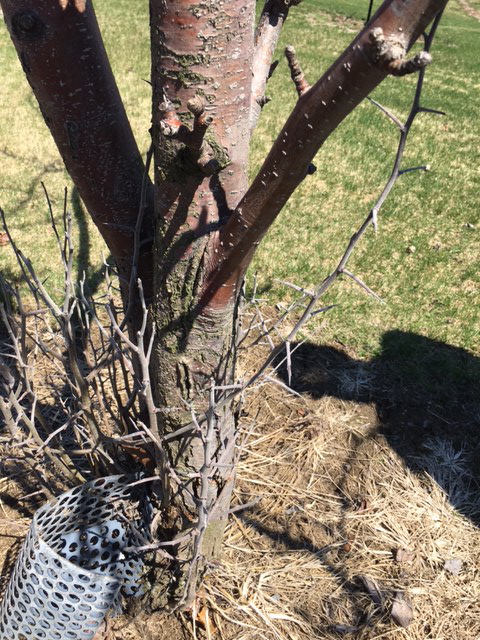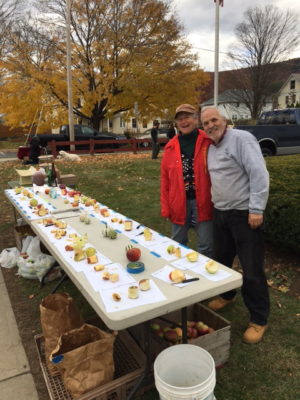Lou and Sue Chadwick of Second Chance Farm in Greenfield Massachusetts are what I consider the “Apple Pied Pipers”. For nearly as long as CiderDays (the oldest cider event in the US) has been running I have seen the Chadwicks touting the bounty of apple varieties. This means they have dozen of fresh picked apples on a long table, that they set up outside no less in early November and welcome everyone to stop by to take a look and try a taste of a Razor Russet, Baldwin or Arkansas Black. If you get a chance to attend CiderDays make sure you say hi to this lovely couple.
In this week’s chat I recorded a walkabout with the Chadwick’s at their Second Chance farm where for the past 12 years they have been nursing small apple varieties and grafting an assortment of rare cider apples ( at least rare right now in 2017 for the US).

Lou made a Rind Graft, a V Graft and an Omega Graft.

Take a look at the Cider Chat YouTube channel to see Lou in action.
The Chadwicks have been orchardists long before Second Chance Farm. Sue’s grandfather has a farm with apple trees in Buckland Massachusetts that they still advise and help the current owners.

Before the walk in the orchard I delve into the winemaking technique known as Bâtonnage.
Bâtonnage defined is simply stirring the lees periodically. This technique can be used in cidermaking and is done after the initial vigorous fermentation is complete.
The lees is brown slurry that settles to the bottom of carboy, stainless steel tanks or barrels. It is comprised of dead yeast cells and heavy particles that were initially floating in the solution.
There are two different types of lees
Gross Lees – the first drop of heavy precipitants that float to the bottom.
Fine Lees – the slurry that can form on the bottom of your carboy after the first racking.
If you leave the lees on the bottom of your cidermaking vessels there is a risk of the lees consuming all the oxygen and causing hydrogen sulfide to form as the cider goes through the process of reduction. (Yes, lees consumes oxygen). The result can leave an off smell such as rotten eggs.
Contact info for Second Chance Farm
Ask for the following 6 #CiderGoingUP Campaign cider supporters – By supporting these cider makers, you in turn help Ciderville.
- Kurant Cider – Pennsylvania : listen to Joe Getz on episode 14
- Big Apple Hard Cider – NYC : listen to Danielle von Scheiner on episode 35
- Oliver’s Cider and Perry – Herefordshire/UK ; listen to Tom Oliver on episode 29
- Santa Cruz Cider Company – California : listen to Nicole Todd on episode 60
- The Cider Project aka EthicCider– California
- Albermale CiderWorks : listen to Chuck Shelton on episode 56
Please Help Support Cider Chat Please donate today. Help keep the chat thriving!
Find this episode and all episodes at the page for Cider Chat’s podcasts.
Listen also at iTunes, Google Play, Stitcher (for Android), iHeartRadio and where ever you love to listen to podcasts.
Follow on twitter @ciderchat
Haven’t downloaded this chat yet? Here is is again.




